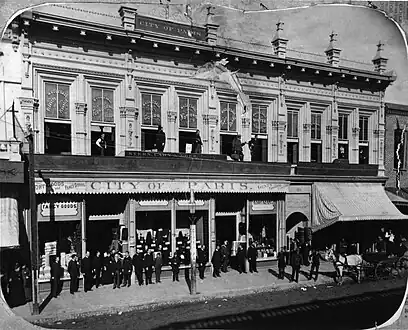Leon Loeb
Leon Loeb (1845–1911) was a French-born American businessman who owned and operated the first department store in Los Angeles. He was a member of the Newmark family through marriage.
Leon Loeb | |
|---|---|
| Born | 13 June 1845 |
| Died | 22 Jul 1911 (aged 66) |
| Spouse | Estelle Newmark |
| Children | 4 including Joseph P. Loeb |
| Family | Harris Newmark (father-in-law) Marc Eugene Meyer (cousin) |
Biography

Leon (Leopold) Loeb, was born to a Jewish family in Strasbourg, Alsace, France,[1] the son of Rosalie (née Levi) and Jacob Loeb.[2] He worked as a bookkeeper in Switzerland before immigrating to Los Angeles in September 1864.[3] He was able to secure a job at S. Lazard & Company (founded by Solomon Lazard and Maurice Kremer) where his cousin Marc Eugene Meyer worked.[2] On 3 March 1874, Solomon Lazard retired and Marc Eugene Mayer, his brother Constant Meyer, and Nathan Kahn (Cahn) purchased S. Lazard & Co. renaming it Eugene Meyer & Company.[4] At Loeb's urging, they promoted the firm as "The City of Paris"[5] (not to be confused with the similarly named store in San Francisco), the city's first department store.[6] The store would grow to be the largest and most elaborate department store in the Southwest.[7][8] On 31 January 1879, Loeb purchased the interest held by Constant Meyer[9] and the firm was renamed Meyer, Kahn and Loeb.[10] In October 1883, Eugene Meyer sold his interest and moved to San Francisco to work for Lazard Frères. After the admission of to Emmanuel L. Stern as a partner, the company was renamed Stern, Cahn & Loeb.[11] After the departure of Nathan Cahn, it was renamed Stern, Loeb & Company until its liquidation in the early 1890s.[10]
Meyer had also been the French Consular Agent in Los Angeles, and he recommended Leopold Loeb to take as consul, which he did in 1883.[12][2] Leopold Loeb served as the French Consular Agent for over fifteen years.[2] The French government awarded him the Officer of the Academy (Officier d'académie).[2]
Personal life
In 1879, he married Estelle Newmark, the daughter of Harris Newmark[1] and granddaughter of Joseph Newmark. They had three children who survived to adulthood: Rose Newmark Levi (b. 1881) married to Herman Levi, Joseph P. Loeb (b. 1883), and Edwin J. Loeb (1886).[1] A fourth child , George, died after several months. Loeb died in 1911.[10]
References
- Selvin, Molly (2015). "The Loeb Firm And the Origins of Entertainment Law Practice in Los Angeles, 1908–1940" (PDF). California Legal History Journal. 10: 141.
- Pawlak, Debra Ann (January 12, 2012). Bringing Up Oscar: The Story of the Men and Women Who Founded the Academy. Pegasus Books (reprint edition). ISBN 9781453226186.
- Levi, Linda. "Loeb and Loeb Law Firm - Pioneer Los Angeles Law Firm 1909 - Present". lindalevi.net.
- "Dissolution of S(olomon) Lazard & Co. And sale to Eugene Meyer". Los Angeles Evening Express. 3 March 1874. p. 3.
- "City of Paris 1874 51-53 Main St., Eugene Meyer & Co. successors to S. Lazard & Co". Los Angeles Times. March 20, 1874. p. 3 – via newspapers.com.
- Rosenzweig, Laura (June 2013). HOLLYWOOD'S SPIES: JEWISH INFILTRATION OF NAZI AND PRO-NAZI GROUPS IN LOS ANGELES, 1933-1941. University of California Santa Cruz. p. 122.
- Carol Felsenthal (4 January 2011). Power, Privilege and the Post: The Katharine Graham Story. Seven Stories Press. pp. 14–15. ISBN 978-1-60980-290-5.
- "Solomon Lazard: Major Jewish Pioneer of Early Los Angeles' Infrastructure". Jewish Museum of the American West. Retrieved 7 Sep 2018.
- "Eugene Meyer added as a partner to Eugene Meyer & Co. 1879". Los Angeles Herald. 20 February 1879. p. 4.
- PIONEER MERCHANTS OF LOS ANGELES. HISTORICAL SOCIETY OF SOUTHERN CALIFORNIA. March 1942. p. 85.
- "Dissolution of Eugene Meyer, Nathan Cahn and L. Loeb. Establishment of Stern Cahn & Loeb 1883". Los Angeles Herald. 27 October 1883. p. 6.
- "25 years ago today (December 26, 1883)". Los Angeles Evening Express. December 26, 1908.